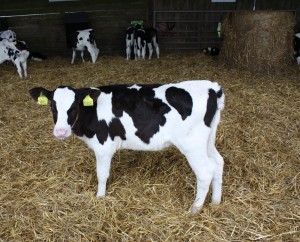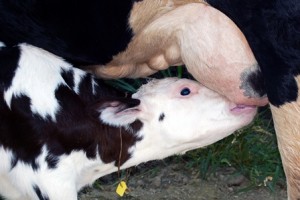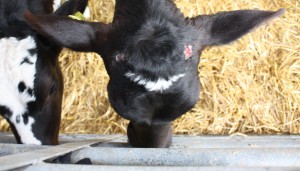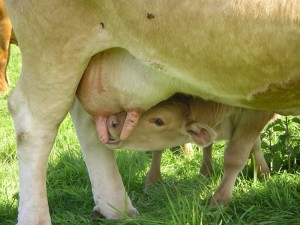Cattle Diseases
Calf Pneumonia
Also known as: Enzootic Pneumonia
Enzootic pneumonia in young calves is a multifactorial disease that occurs mainly in two different systems:
- In housed dairy calves reared for replacement
- In housed calves reared for beef either in the herd of origin (Assié et al., 2004), or after sale to a finisher.
What Causes Calf Pneumonia?
Control and Prevention
Risk Factors
Treatment Options
Welfare
Good Practice
Dairy calves are likely to suffer from the disease at any age, with it manifesting itself as a chronic, coughing pneumonia, or as a more acute, enzootic calf pneumonia. Older dairy calves are also vulnerable after housing in the autumn. Suckler calves are more likely to suffer from respiratory disease between two and five months of age, following weaning or transport from one herd to another. Outdoor reared beef suckler calves can also be severely affected by pneumonia (Peters, 1986; Scott, 1997).
In older calves, mainly in weaned suckler calves aged six months to two years, respiratory disease is likely to occur after transport or other environmental stress and is often called shipping or transit fever. (see: Pasteurellosis). Similarly, a respiratory disease caused by lung parasites, (Dictycaulus viviparous, also known as husk), occurs in older calves. However, it should be remembered that lungworm can occur in young calves, even when housed if exposed to significant challenge from carrier dams or contaminated bedding (Crawshaw and Smith, 2003; SAC Veterinary Services, 2006). A viral respiratory disease caused by the infectious bovine rhinotracheitis virus (IBR), is also more significant in older animals.
Enzootic Pneumonia in Calves

Duchy College calves in the calf shed. There should be enough space in the calf pen to allow calves to groom themselves, lie down and stretch their limbs and rise without any difficulty.
Enzootic pneumonia in young calves can be chronic and be present with very few clinical signs apart from a dry cough and slightly increased respiratory rate. The acute form of the disease usually manifests itself in an outbreak involving several calves going down with the disease within a 48-hour period. Fever, dullness, inappetance and coughing, often combined with nasal discharge, are the most common symptoms.
There are very little data available on the prevalence of enzootic pneumonia in UK cattle herds, as recording of calf diseases is seldom carried out. Respiratory diseases are, however, considered the second most important cause of death and ill -thrift in calves. The condition is farm related, with some farms suffering serious losses due to calf pneumonia, while on others the disease is either very mild or non-existent. Sporadic outbreaks can, however, be experienced by farms that normally see very little respiratory disease in calves.
Causes of Calf Pneumonia
Pneumonia in calves is a multifactorial disease. Infectious agents (pathogens), environment, management and the immune status of the calves are factors in determining the outcome of an infection.
Pathogens Causing Calf Pneumonia
A multitude of pathogens, including viruses, bacteria and Mycoplasma spp (M. bovis, M. dispar and M. canis), are involved in different combinations on different farms (Ayling et al., 2004; Bryson et al., 1978; Caldow et al., 1988; Dyson and Linklater, 1976; Uttenthal et al., 1996). It is often suggested that the viruses and mycoplasmas are the primary infections and the bacteria cause a secondary infection in an animal whose defenses have been weakened by the first infection. The most common viruses isolated from enzootic pneumonia cases are:
- Respiratory syncytial virus (RSV)
- Parainfluenza III virus (PI3)
- Infectious bovine rhinotracheitis virus (IBR)
- Bovine viral diarrhoea virus (BVD), has also been implicated in the bovine respiratory disease complex, not as a primary pathogen, but as a disease agent causing immunosuppresion.
Mycoplasmal agents are usually considered to be the most common agents causing the chronic form of enzootic pneumonia, even though Mycoplasma bovis has been identified as the causative agent in many acute outbreaks as well.
The most commonly isolated bacterial organisms are:
- Mannhaeimia spp.
- Pasterurella multocida
- Hemophilus (Histophilus) subspecies (H. somnus).
Risk Factors for Calf Pneumonia
Inadequate ventilation of calf barns increases the risk of disease due to the buildup of humidity, noxious gases, dust and bacteria content (Lorenz et al., 2011). The main environmental risk factor predisposing calves to respiratory disease is poor ventilation in calf housing (Pritchard, 1982). Cold, humid conditions, sudden changes in air temperature, stress due to different causes and change in the environment have also been associated with outbreaks of pneumonia in young calves (Phillippo et al., 1987; Roe, 1982; Scott, 1995; Webster et al., 1985).
Inadequate intake of colostrum or poor quality colostrum will affect the calves’ defense against respiratory agents and make them more susceptible to infection (Virtala et al., 1999). Rearing systems where calves of different origin are mixed together at a young age suffer from high levels of respiratory diseases (Gibbs, 2001). Large, shared air spaces, calves from different age groups and poor sanitation between calf batches often make these systems even more vulnerable (Losinger and Heinrichs, 1996). The stress associated with management procedures such as disbudding and castration may also be associated with a high respiratory disease incidence.
Control and Prevention of Calf Pneumonia
Management of calf pneumonia is reliant on a good understanding of the causes and risk factors (See table). The incidence and severity of calf pneumonia is closely allied with management and disease patterns on farms and so the best approach is to implement a control program tailored to the individual farm’s needs. (Gibbs, 2001). These approaches can be divided into three areas:
1. Maintenance of Disease Resistance

Antibodies within good quality colostrum will boost the calf’s immune system and make them more resistant to infection
Passive immunity is the transfer of antibodies from one individual to another and can be in the form of maternal antibodies in utero crossing the placenta, or lactationally in the colostrum. In order to provide the calf with passive immunity protection before its own immune system is fully functional, the calf needs to receive adequate amounts of colostrum containing a sufficient quantity of antibodies (also known as immunoglobulins). An amount of 3-4 liters of colostrum that contains 50-150 g/liter of Immunoglobulin IgG within the first 24 hours of life has been recommended (Besser et al., 1991).
While the transfer of maternal immunity is important, it does not protect the calf well against respiratory pathogens after two to three months of age because the concentration of maternal serum antibodies is low and the calf’s own immune system is still not fully functional (Corbeil et al., 1984). The highest incidence of respiratory disease occurs in many herds during this period, and prevention should concentrate on reducing stress at this time.
A further factor limiting immune protection against respiratory diseases is that some of the pathogens are immunosuppressive (Woldehiwet and Sharma, 1992). Mycoplasma bovis, RSV and BVD belong to this category and, when endemic in a herd, can reduce the calves’ ability to fight off disease. Eradication of M. bovis from a dairy herd has been shown to improve calf health (Byrne et al., 1998).
Vaccines are widely used to boost the calf’s immunity against many respiratory pathogens. Vaccines are available in the UK for RSV, PI3, IBR, BVDV and Pasteurella, including several in combination. The vaccines should be used as a part of a disease prevention program that also addresses the environmental and management factors on the farm (Richardson, 2004). Vaccines can also be used to eradicate some respiratory diseases in problem herds (Pospísil et al., 1996). However, the efficacy of the vaccines varies significantly between farms, and it is difficult to establish control programs that work continuously (Van Donkersgoed et al., 1990; Howard et al., 1987; Straub and Mawhinney, 1988). Some modified live vaccines can also be used successfully in the face of an outbreak once the first affected animals have been diagnosed and the agent identified. It is important to check the datasheets for all vaccines before use as only some are live and all have different protocols for administration, requirement for second vaccinations and duration of immunity. Vet advice should always be sought and vaccination use should be part of the herd health plan.
Prophylactic use of antibiotics has also been successful in calf rearing units, with antibiotics being administered to all arriving animals. This practice is, however, should not be relied upon in any system.

In order to reduce stress disbudding and castration could be timed so they do not coincide with weaning or autumn housing.
2. Reduction of Stress
Gradual weaning, timing of disbudding (or dehorning) and castration not to coincide with weaning, minimization of transport, avoidance of cattle markets and avoidance of cold stress have all been recommended as ways to reduce stress in young calves. Respiratory diseases often follow a pattern in a herd. Recording disease incidences and treatments can be helpful in establishing whether such a pattern exists. If a pattern is identified, potential stressful events around disease peaks can be recognized and management practices changed to reduce stress.
Overcrowding, poor ventilation and high humidity all cause respiratory stress in calves and make them more susceptible to respiratory disease. Reasonable space allowance and good ventilation will reduce this stress and make pneumonia less likely.
3. Minimizing Exposure to Infection
Close contact with other animals allows respiratory pathogens to spread easily. Individual housing of dairy calves either indoors or outside is generally linked to improved calf health (Lorenz et al., 2011). There is long-term recognition of the benefit to dairy calf health of outdoor housing in hutches especially for the prevention of diarrhea and respiratory disease (Davis et al., 1954).Similarly, keeping age groups separate and group sizes small has been shown to reduce respiratory disease (Lorenz et al., 2011).
Introduction of animals from other herds carries a risk of disease transfer, even in virtually closed herds, where only occasional replacement animals are brought in. Keeping recent purchases separate from the herd for 2-3 weeks to ensure that they are not incubating a respiratory disease is an adequate control measure.
Treating Calf Pneumonia
In the face of an outbreak of enzootic pneumonia in a closed herd or when a chronic problem is recognized, it is important to attempt to identify the causative agents and management and environmental factors in order to target preventive measures in the future. There are a number of investigative techniques that can be used in the face of a pneumonia outbreak. These include:
- Taking nasal swabs and / or bronchioalveolar lavage (BAL) samples for bacterial culture and virus isolation
- Paired blood samples can be taken to assess serological immune response to respiratory pathogens. However, reliance on paired serological testing must be done with caution as false negatives (failure to seroconvert) can occur in young calves less than 3 months old (Virtala et al., 1999).
For the acute form of enzootic pneumonia, nursing and isolation of affected calves is important in all treatment regimes. Vitamins can be administered as a supportive therapy, and a multitude of treatments from antihistamines to expectorants have been found effective in alleviating the condition. Antimicrobials and both steroid and non-steroid anti-inflammatory drugs are usually the main line of treatment. Antibiotics can be used in in-contact animals (metaphylaxis) as well as in the affected ones. Vaccines can occasionally be used for the in-contact animals, and have been shown to provide protection when the causative agent is identified fast enough (Gourlay et al., 1989; Laven and Andrews, 1991).
In all cases antimicrobial treatment should be under veterinary guidance and should be outlined in the farms’ herd health plan.
The chronic form of calf pneumonia is normally not treated unless the calf has a severe cough. Antibiotics, when chosen carefully, may be effective, although severe lung damage may not resolve. It should, however, be noted that chronic enzootic pneumonia in calves is a herd problem. When the condition becomes severe enough to require treatment, it is necessary to attempt to identify the causes of the condition. Improvement of the management and environment or eradication of the causative agent/agents with the help of a comprehensive disease control plan is required.
Calf Pneumonia and Welfare
Prior to weaning, single suckled beef calves reared in outdoor systems are at lowest risk of pneumonia (Lorenz, 2011). For suckler calves born and reared indoors the incidence of pneumonia can be considerable (Assié et al., 2004). Therefore, the isolation of affected calves, effective treatment with antibiotics and supportive therapy and provision of dry and warm conditions are vital in the treatment, in order to avoid further suffering. The fact that many respiratory problems can be avoided by good management adds to the need to tackle calf pneumonia problems if they exist in herds.
Good Practice Based on Current Knowledge
Prevention and control of calf pneumonia should be an important part of a farm’s herd health plan. Good practice to control and prevent enzootic pneumonia in young calves can be divided into three areas of action
1. Building immunity:
- Do not separate the dam until 24 hours after calving
- Provide adequate bedding to allow the calf to stand without difficulty
- Ensure early colostrum feeding; assist if needed, and monitor the intake as closely as possible and record it (“maximum supervision, minimum interference”). Calves should consume approximately 10% bodyweight in colostrums in the first 6 hours of life (i.e. approximately 4-5 liters for an average calf, or, a minimum of “6 pints in 6 hours”)
- Keep a supply of frozen colostrum in case the dam leaks colostrum before calving
- Avoid stress and exposure to new disease agents during “poor immune capacity” at 2-4 months of age
- If immunosuppressive respiratory pathogens are a known herd problem (i.e. BVDV), consider eradication or vaccination
- Vaccinate strategically as a part of a comprehensive disease control plan
2. Minimization of exposure:
- Provide adequate numbers of calving pens and clean and disinfect them between batches
- House calves of different ages in different rooms or with adequate separation
- Quarantine bought-in animals for 2-3 weeks before introduction to the rest of the herd
- Provide good ventilation in the calf housing (a minimum of 6m³ airspace for calves up to 6 weeks old; 10m³ for calves up to 12 weeks and 15m³ for calves up to 16 weeks old)
- There should not be excessive humidity in the calf house
- In difficult circumstances, consider calf hutches (tethering not acceptable under UK organic standards).
3. Reducing stress:
- Avoid overcrowding in calf pens
- Provide good ventilation (There should be 6 air changes per hour)
- Make sure that calves are well bedded during cold weather and do not suffer from draught (the minimum critical temperature for new-born calves in a straw bedded pen is 6ºC)
- Provide shelter during prolonged cold and wet conditions on pasture
- Avoid transport and introduction to new environment between 2 and 4 weeks of age
- Time castration and disbudding away from weaning
- Time autumn housing away from castration and disbudding
- Introduce diet changes gradually, particularly when housing calves


 British English
British English


Comments are closed.